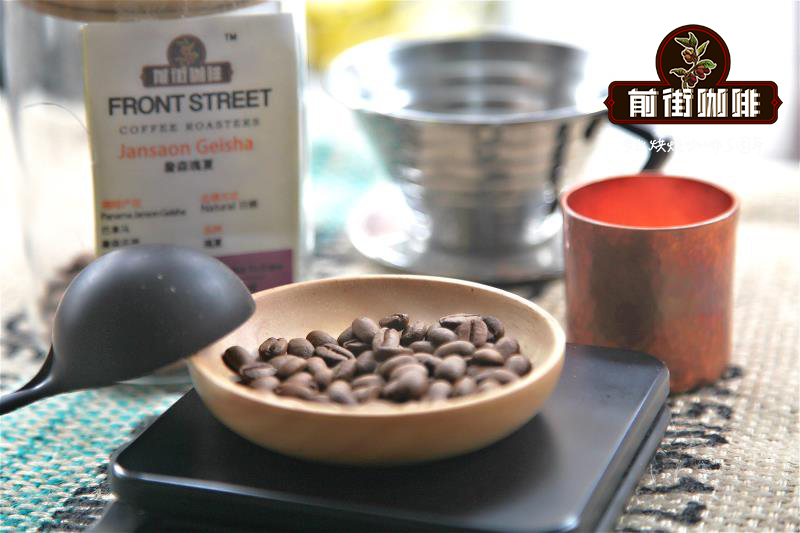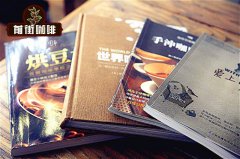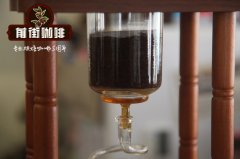How Kopi Luwak was discovered how to produce Kopi Luwak in the process of industrialization

Professional coffee knowledge exchange more coffee bean information please follow the coffee workshop (Wechat official account cafe_style)
Kopi Luwak, the local people call it "Kopi Luwak", Europe and the United States also call it "Luwak Coffee", the domestic generally translated as "musk cat coffee", of course, you have heard the most, must be the more sensational name "Kopi Luwak". Yes, it does get it from the poop pulled by the civet!
The shape of Kopi Luwak
Civet coffee first entered the eyes of global coffee consumers after a lot of media hype in 2002. In New York, a pound of such coffee beans cost $500, while in Hong Kong's top hotel cafes, a cup of civet coffee costs $50. And even if you have money, you may not be able to drink it, because at that time the annual output of civet coffee in Indonesia was less than 500 kilograms, and the output was so low that it was hard to get a single bean.
Coffee lovers in China learned that this kind of coffee is relatively late. Originally, the overall consumption level of coffee in our country is very low, and this kind of expensive and minority beans are rarely known. However, with the continuous development of Chinese coffee drinking habits in recent years, and fuelled by all kinds of strange news on social media, civet coffee has quickly become a craze in China. A number of cafes featuring Kopi Luwak have sprung up in first-and second-tier cities like bamboo shoots after a spring rain. This magical coffee is also treated as a luxury because of its high price, and has become a symbol of high-end boutique coffee.
1. Where is the unique taste of Kopi Luwak? # #
The civet is an animal that sleeps during the day and goes out at night. They like to eat the fruit of coffee, but they can't digest the hard seeds, so the coffee beans will be excreted with their feces. The long-term evolution of civets has developed the ability to accurately select the reddest, best and most juicy coffee fruits to eat in the dark, and this natural selection mechanism is sometimes even better than human manual selection, so the coffee beans in the civet feces are usually the best quality coffee beans.
The civet is an expert at choosing coffee.
While the flesh of coffee is digested in the civets' intestines, the enzyme also decomposes the protein in the coffee beans, which is an important component that produces bitterness when the coffee is roasted, so the musk cat coffee has a lower bitterness and a smooth taste than the general coffee beans. In addition, the aromatic gland sacs in the civets' intestines can secrete special aroma substances, which also add a unique flavor to the coffee beans.
According to people who have drunk the most original civet coffee of origin, the coffee tastes mild, with dark chocolate, earthy, smoky and musk aromas (although the fishy and smoky flavors may be related to the way the beans are roasted) and have a good consistency. But is this taste really worth $50 a cup? We'll talk about it later.
two。 What did the first person who discovered Kopi Luwak do? # #
Many people wonder: how on earth do people think of using cat shit to make coffee?
Stop it! Kopi Luwak, of course, does not directly take the shit to brew, but to rinse it clean, okay?
In fact, Kopi Luwak used to be a real coffee for the poor. In the early years, Indonesian coffee farmers were very poor. When coffee was harvested, the government would buy coffee beans at low prices in batches and process them for export. Of course, the poor cannot afford to drink the finished coffee sold on the market, so they can only pick up scattered coffee beans in the forest or collect defective coffee beans to drink themselves. locals know that civets will only choose the best coffee fruits to eat, so when they see the coffee beans left in the civet feces, they are naturally reluctant to throw them away, pick them up and clean them, and then stir-fry, grind them, and soak them in water to drink. This kind of coffee beans, which used to be despised and disdained by others, has now become a luxury, which is ironic.
3. How is Kopi Luwak industrialized? # #
As mentioned earlier, around 2002, adventure-hunting tourists and the media discovered this magical flavor of coffee and made it public, making its price soar. The local government and coffee farmers naturally would not miss the opportunity to get rich and compete to collect Kopi Luwak, and its output has also gradually increased.
However, in the process of industrialization, it is a famous public event-the SARS incident.
As we all know, in 2002-03, SARS swept the world, an animal called masked palm civet, was considered to be the host of SARS virus, and was recognized by the public. Musk cat and masked palm civet both belong to the spirit cat family, so they are also culled on a large scale.
At that time, when the price of civet coffee remained high, shrewd coffee farmers found the right time to buy hunted civets in bulk at a low price, raise them in captivity and produce civets "full-time". It can be said that it is the SARS incident that indirectly promoted the industrialization of civet farming and Kopi Luwak.
Captive civets
But the industry is fragile: the civet is a wild animal that is very aggressive and must be raised in separate cages, but it is easy to get sick when kept in narrow cages. At first, coffee farmers regarded civets as honored guests, choosing not only good coffee fruits to feed, but also bananas, mangoes, insects and other civets' favorite foods, and when necessary, they were fed vitamins to keep them healthy. the cages should be cleaned and kept clean regularly. However, with the continuous increase in production and the decline in prices, in order to save costs and earn higher income, coffee farmers have intensified their "exploitation" of civets and have no time to improve their breeding environment, resulting in a great increase in the mortality rate of captive civets. In the end, the production of real civet coffee is very limited.
In recent years, there are also some powerful large landowners who have switched to small-scale breeding in the paddock to allow musk cats to move freely. But no matter how much it is improved, many data and actual cup tests show that although captive civets produce more Kopi Luwak and have a brighter and tidier appearance, they don't taste as good as wild Kopi Luwak. Nature must be fair.
4. Is there any other "animal shit coffee"? # #
The answer is, of course, you must have heard of the so-called "black gold"-like dung coffee.
Elephant dung coffee
Elephant dung coffee was created by Sri Lankans who were inspired by Kopi Luwak, but I would like to spread a rumor here: elephant dung coffee is basically just an experimental product taken for granted by the local people. It has been tried on a small scale, but it has never been really recognized by the coffee industry. Promotion has not been successful.
Sri Lankans see that the price of Kopi Luwak is very high but the output is very low, so they think of the local elephants: the droppings of elephants are so huge, if they are used to produce coffee, the output must be high, with a lot of money!
This idea cannot be said to be absolutely wrong, because the basic principle is to use the intestines of animals to ferment coffee beans, which is called "in vivo fermentation". But it is conceivable that the digestibility of each animal is different, and it is impossible to achieve a balanced degree of fermentation like the civet, and the elephant does not have the aromatic glands of the civet, so the elephant dung coffee was stillborn after being hyped for a period of time. A similar example is the Indian "rhesus monkey coffee", which uses monkey saliva to ferment, which is said to be effective, but it has not been promoted.
On the contrary, Brazil, a distant coffee country, found another suitable animal-the fleshy Phoenix-crowned pheasant.
Fleshy Phoenix-crowned pheasant
The fleshy crested pheasant is a bird species endemic to South America. Like the civet, it is also an expert at eating and selecting coffee fruits. However, because this pheasant is a vegetarian and its digestive ability is weaker than that of civets, its pods of "bird shit coffee" have not yet been digested completely, and they have to be shelled in addition to washing, which reduces the degree of fermentation to a certain extent. but at the same time, it also reduces the smell of coffee beans.
Bird shit coffee
On the other hand, the Phoenix-crowned pheasant eats yellow bourbon Arabica coffee, which is a specialty of Brazil, whose quality is "nowhere higher" than Robsta coffee, which is common in Indonesia, and Brazil has the highest coffee output in the world. Although this kind of "bird shit coffee" is also expensive, it is much more reasonable than Kopi Luwak, and it has also won a higher evaluation than Kopi Luwak in the taste cup test, which means that it can catch up from behind.
5. Whether Kopi Luwak does not live up to its name # #
I think: indeed!
First of all, fakes are rampant. Even if it has been industrialized, the production of real civet coffee is still very low. Most of the civets on the market are either coffee beans fermented in other animals or simply impersonated by ordinary coffee beans. Anyway, 99% of consumers can't tell the difference in coffee taste at all.
Secondly, most of the civets live in the tropical rain forests of Southeast Asia, where the varieties of coffee grown are mainly robusta, and the quality of robusta is generally far lower than that of Arabica. (Robusta coffee beans are also a general raw material of instant coffee, cheap, bitter, lack of flavor, and high caffeine content), so the core of musk coffee-coffee beans-is not necessarily very good.
The difference between Arabica and Robusta
Finally, although we said earlier, civets have natural discrimination and can choose good coffee beans, it is difficult to control, and the process of digestion and fermentation must be uneven, so it is difficult to produce Kopi Luwak with stable quality.
6. Conclusion #
To sum up, Kopi Luwak does have a unique flavor, and "scarcity is precious", but at best it can only be regarded as a "curiosity-hunting variety". Coffee cultivation and production has a long history, has long formed a complex and rigorous system, for high-quality coffee has a clear definition, really love coffee, should know more about the origin and taste of coffee knowledge, do not need to spend Kopi Luwak so high price, you can taste really good coffee. In the future content of Chestnut Weekly, we will also introduce more knowledge of boutique coffee. I hope you will continue to pay attention to it.
Important Notice :
前街咖啡 FrontStreet Coffee has moved to new addredd:
FrontStreet Coffee Address: 315,Donghua East Road,GuangZhou
Tel:020 38364473
- Prev

How to distinguish the true and false flavor of Kopi Luwak the characteristics of natural fermentation of Kopi Luwak taste and flavor
Professional coffee knowledge exchange more coffee bean information Please pay attention to the coffee workshop (Wechat official account cafe_style) Kopi Luwak is an island noodle produces coffee fruit, but there is a kind of cat on the island especially likes to eat coffee fruit, so people kill cats, but can not kill clean, there are always coffee fruit stolen by cats. There was a coffee plantation owner who once did not get enough coffee beans, so he began to collect coffee from
- Next

Why is it bad to make coffee by hand? why do beginners fail to make coffee by hand?
Professional coffee knowledge exchange more coffee bean information please follow the coffee workshop (Wechat official account cafe_style) hand-brewed caffeine brewing methods and utensils are easy to use, in recent years in Europe and the United States, Japan popular. For hand-brewing coffee, you need to use a hand-brewing pot with a smaller spout to avoid insufficient extraction caused by too much water during brewing. Most of the coffee is filtered by filter paper, but it will filter out the grease and wind of coffee powder.
Related
- Beginners will see the "Coffee pull flower" guide!
- What is the difference between ice blog purified milk and ordinary milk coffee?
- Why is the Philippines the largest producer of crops in Liberia?
- For coffee extraction, should the fine powder be retained?
- How does extracted espresso fill pressed powder? How much strength does it take to press the powder?
- How to make jasmine cold extract coffee? Is the jasmine + latte good?
- Will this little toy really make the coffee taste better? How does Lily Drip affect coffee extraction?
- Will the action of slapping the filter cup also affect coffee extraction?
- What's the difference between powder-to-water ratio and powder-to-liquid ratio?
- What is the Ethiopian local species? What does it have to do with Heirloom native species?

